At 90, David Kurtz still teaches how to be great at kayaking
BELLEFONTE, Pa. _ It’s a common sight in this leafy Pennsylvania borough.
About a half mile downstream from downtown, an elderly gentleman weaves a fiberglass kayak in and out of slalom gates hanging over the waters of Spring Creek. Pedestrians and fly fishermen walking along the banks wave, the kayaker smiles and waves back.
At the end of the run, the wiry man slings the boat over his right shoulder and walks stiffly to his car. The gnarled fingers grip a sleek black paddle as a look at his face reveals a wide-eyed and tooth-filled grin, stretching from cheek to cheek.
That’s the picture of 90-year-old David Kurtz, who has spent the better part of the last 60 years training and coaching paddlers at the Sunnyside Paddle Park.
A veteran of four World Championships dating back to 1963, Kurtz is known for bringing U.S. kayaking to the international stage while also turning his expertise to the local scene and helping hundreds of students learn how to paddle.
The accolades continue as the retired chemistry professor has guided and trained three different regional paddlers in the last 20 years to over a dozen world competitions including the U23 World Championships, the Pan American Championship and the Junior Olympics.
“He’s had some phenomenal accomplishments, he’s traveled, he’s done incredible things,” says one of those students, 28-year-old Evan Van Horn of Bellefonte, who competed in the 2013 U23 World Championships and the 2009 Junior Olympics. “He’s done all of these things because he loves it so much.”
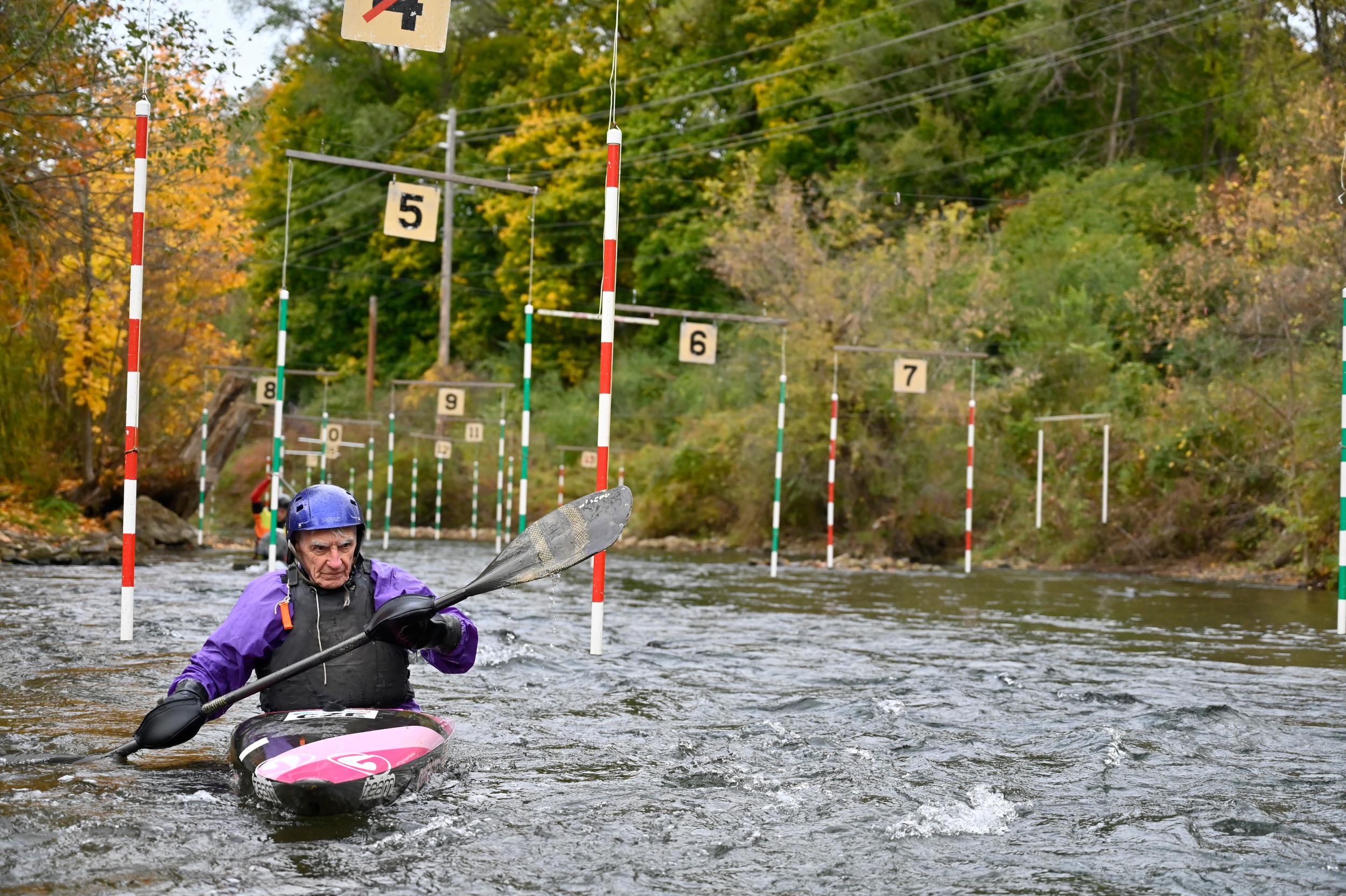
David Kurtz turns upstream to pass through a reverse slalom gate at Sunnyside Paddle Park on Monday, Oct. 17, 2022, in Bellefonte, Pa. In slalom kayaking, the green gates are passed through the front, and the red gates must be passed through the down-river side. ~ photo by Luke Vargas
Kurtz makes you want to get better, Van Horn says. He always keeps the focus on the positive.
“If I make mistakes, I’m not going to upset him or disappoint him, it’s always a learning experience,” Van Horn says.
But for all of those successes, Kurtz is practically unknown outside of the kayaking circle that whirls on the small stream that runs through this town of 6,000 in central Pennsylvania, about 12 miles from the main campus of Penn State University. The school is where Kurtz, a graduate student in 1954, was introduced to the sport.
“It’s fun,” Kurtz says with a laugh. “It’s fun, and you can’t deny it. It’s not only fun, but it’s a challenge to be able to maneuver a boat in whitewater situations. Every stroke you take is different.
“The thing that really keeps you going is that you’re trying to train and get other people to do the same thing. You start with the young ones and keep working with them as they get older and older.”
Learning to paddle
Kurtz’s journey in his sport began in 1946 when the Evanston, Illinois, native learned to paddle at Boy Scout camp. He was just 14 then, but he wouldn’t get back into a boat until he came to Penn State for graduate school in 1954.
The day he arrived in Happy Valley, Kurtz was shown around campus by upperclassmen who happened to be members of the Penn State Outing Club.
“They mentioned that they were having a paddling trip this weekend, and ‘Would I like to go?’” Kurtz said. “‘Sure, I’ll go along. I’m not a very good paddler, but I’ll go.’
“So that was my very first weekend in State College, at Penn State, and I haven’t stopped since.”
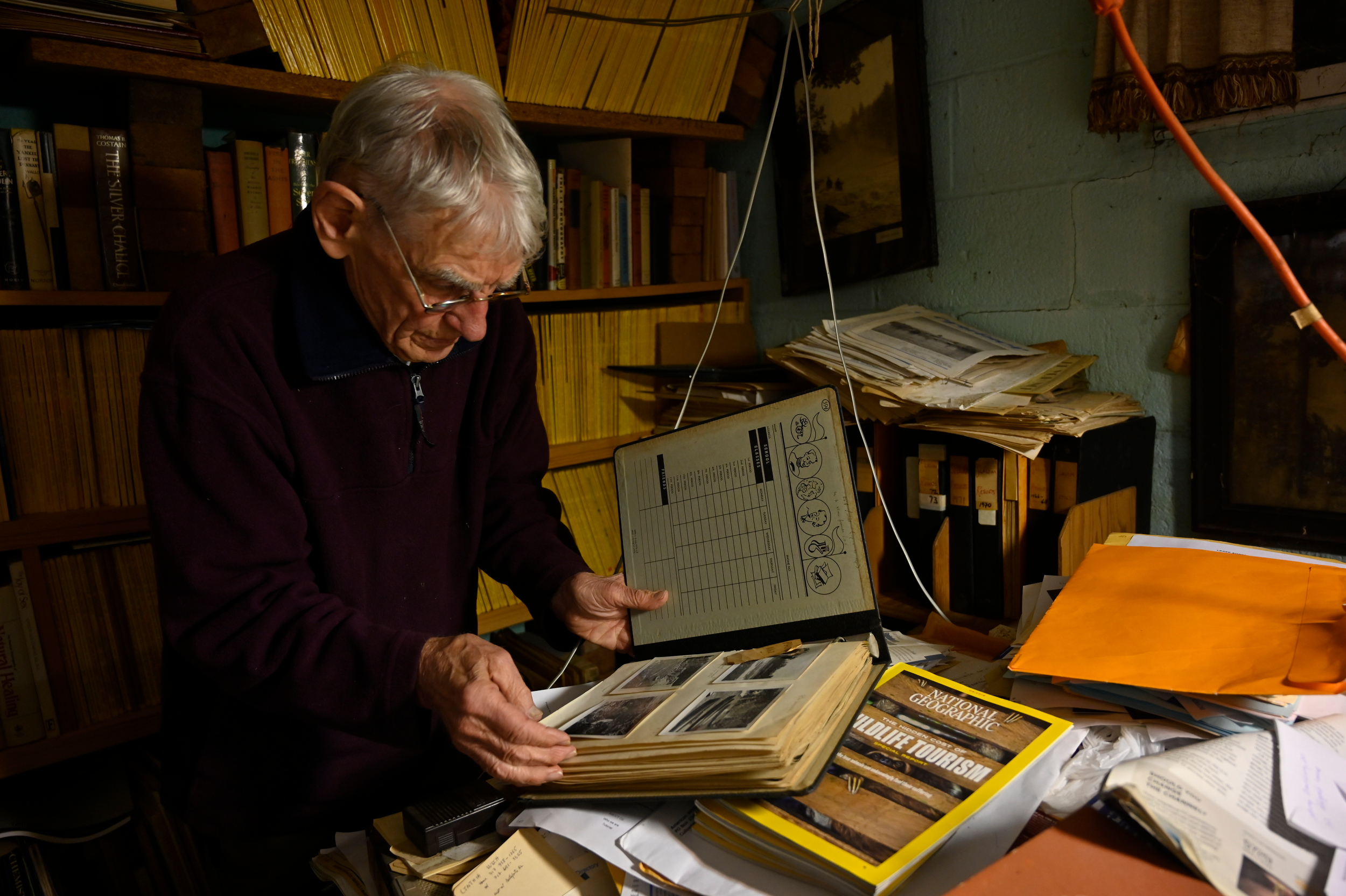
David Kurtz flips through record books of his races in the basement of his home in State College, Pa. ~ photo by Luke Vargas
Back in the ‘50s, Kurtz said the Penn State Outing Club “did some wild stuff,” adventures that would likely fail to get permission from university attorneys these days.
On one of those outings, Kurtz and the club made one of the first descents _ meaning a trip that opens up a waterway for future paddlers _ of the upper section of the Youghiogheny River.
“The River Gypsies’ Guide to North America,” a whitewater guidebook, describes the Upper Youghiogheny as “one of the most legendary stretches of whitewater on the continent” and “an age-old classic where generations of boaters have honed their craft.”
The group not only made it down the Upper Yough, but Kurtz and company completed it in 15-foot aluminum canoes. Today, the river is run mostly by closed-decked, rotomolded-polyethylene kayaks, a huge jump in the sophistication of paddlers’ equipment.
Finding a Passion
The outing club continued to pioneer new rivers throughout Pennsylvania, but it didn’t take long before Kurtz discovered a new form of paddling that would become his life passion — slalom racing.
Members of the club started doing “bottle dodges” in Penns Creek. They would anchor empty gallon jugs or bottles to the bottom of the river with string and then dodge the floating obstacles in their canoes.
Eventually, the group got more elaborate in their attempts to recreate slalom paddling, a sport that had only debuted two decades earlier in Europe.
“We got a hold of some wire and stretched a couple of wires across rapids,” Kurtz said. “I remember at Penns Creek, we found a couple of long sticks in the woods and tied them onto the wire somehow. Those were our gates.
“Improvisation was critical in those days. We had to create our own equipment.”
Kurtz earned his doctorate and master’s in chemistry from Penn State in 1960, and a year later, he was working for the university as a scientist and running an Explorer Post for local Boy Scouts interested in paddling.
During the day, he’d work in the lab at Penn State, and in the evenings, Kurtz would hit the river.
In July 1961, Kurtz led a trip for the Scouts to set up a slalom course on the West Branch of the Susquehanna River. While they were loading the van with their slalom poles, a Slovenian paddler named Natan Bernot happened to walk by.
Intrigued by the slalom poles, Bernot asked if he could come along for the trip. The Boy Scouts immediately invited him.
However, it was without Kurtz’s approval.
“It was upsetting to me because he had the reputation of being sort of a wild paddler,” Kurtz said. “I was teaching conservative paddling at the time. But I could not object to the invitation that the boys had given.”
The Boy Scouts’ impulsive offer turned out to change Kurtz’s life.
At the time, Bernot was already an accomplished paddler on the world stage, and two years later, he would go on to finish second at the Slalom World Championship in doubles canoeing.
At the end of the trip, the Slovenian paddler told Kurtz if he had a better boat and trained more, Kurtz was good enough to go to a world championship.
This came as a bit of a shock to Kurtz.
“Here I am, one of these low-activity persons, who was never interested in sports, getting involved in the whitewater program,” Kurtz said. “In grade school, I was always the last person chosen or the second-to-last person chosen. I was a real klutz.”
This was the beginning of a “treasured story” for Kurtz. Bernot sent him drawings for a new kind of canoe that had yet to be introduced to the U.S. paddling scene.
Bernot had made designs for one of the first decked canoes made of fiberglass, a relatively new material. Prior to this, canoes were open-decked and allowed water to pour into the boat when paddling through rapids, which would weigh it down during a race.
Kurtz had to build a prototype out of wood from the drawings and develop a mold to shape the fiberglass. After months of work, Kurtz along with two Scouts from his Explorer post, Tom Southworth and Dave Guss, built and paddled four of the first fiberglass decked canoes in the United States.
In their newly crafted boats, the trio swept the competition at the U.S. national team trials, discovering their canoes were far more maneuverable.
The Boy Scouts' impulsive offer turned out to change Kurtz’s life.
The three qualified to be on only the second U.S. slalom team in history and compete at the World Championships in Spittal an der Drau, Austria, in 1963.
Kurtz accompanied Southworth and Guss, who were just teenagers at the time, to Europe where the three trained for several weeks.
The championship was dominated by eastern European paddlers, but Kurtz finished 17th, with Guss and Southworth taking 19th and 21st, respectively.
This would be the first of four trips to the World Championships for Kurtz, and in the decades that followed, he would travel around the world as a race judge, team manager, member of the international slalom committee and coach.
From Athlete to Coach
After the 1963 World Championships, Kurtz returned to the U.S. knowing Americans had fallen behind in slalom paddling. Determined to remedy this, he built Sunnyside Paddling Park on Spring Creek to train the next generation of kayakers and canoers.
In the middle of Bellefonte, Kurtz has had the opportunity to pass on the sport of paddling to hundreds of students. He also founded a competitive racing team, Mach One.
Of those trained under Kurtz, 20-year-old Alden Henrie is one of the standout paddlers. Henrie started paddling with Kurtz when he was 8 years old, and since then, the Snowshoe, Pennsylvania, native has competed in two junior and two U23 World Championships.
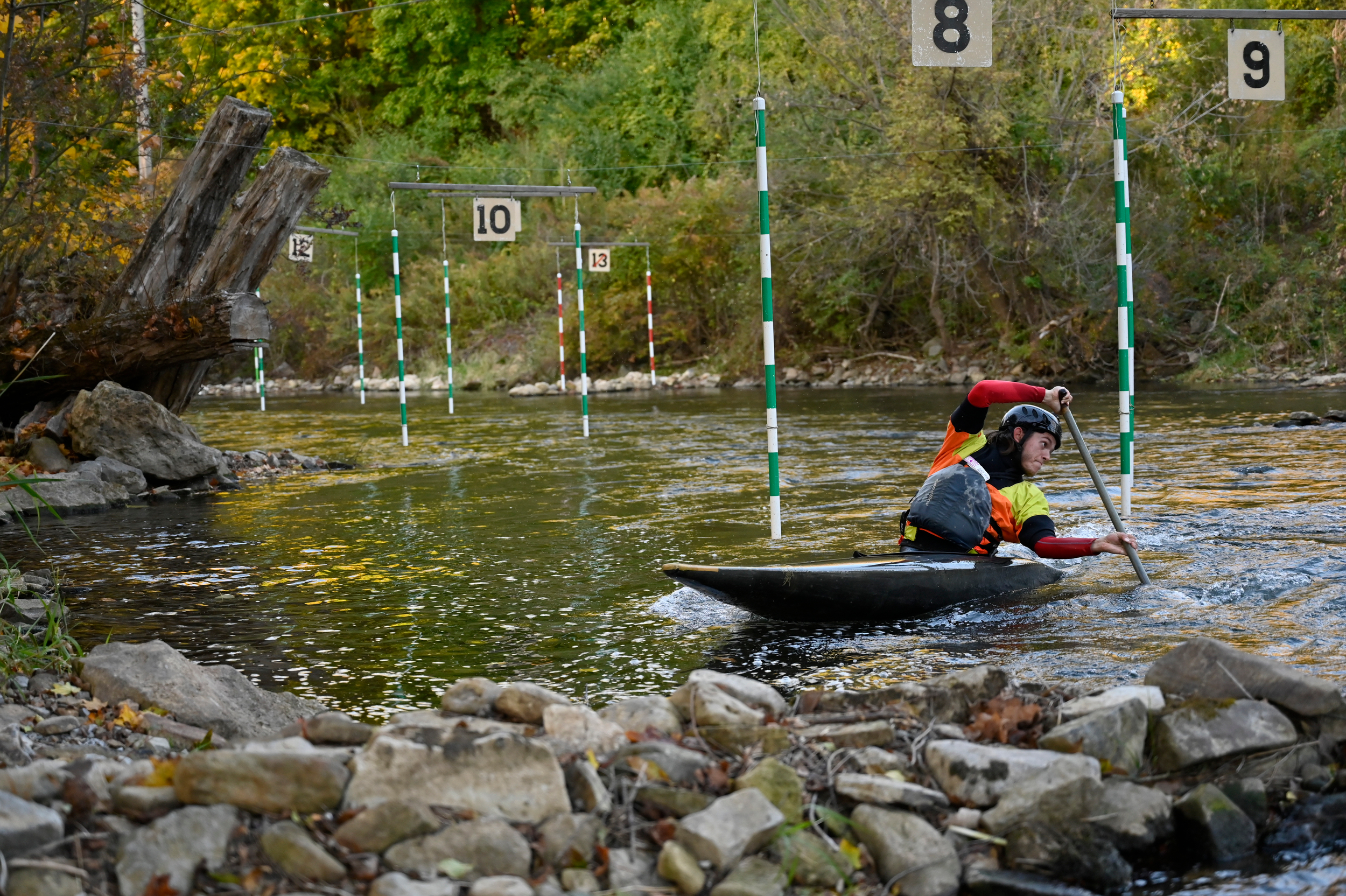
Alden Henrie reaches back to catch an eddy through a slalom gate at Sunnyside Paddle Park on Wednesday, Oct. 25, 2022, in Bellefonte, Pa. Sunnyside Paddle Park is located on Spring Creek, and it was built by David Kurtz after the 1963 slalom world championships. ~ photo by Luke Vargas
Henrie said Kurtz is an “American whitewater legend,” but his true greatness as a coach lies in his ability to instill the fundamentals of paddling on his students.
“You name the type of stroke, and Dave is an expert on it,” Henrie said. “He’s a very good technician, and it’s his ability and his mastery of paddling technique that he does his best to instill upon any one of his students when they first start out.”
Recently, Kurtz named Henrie as one of the coaches of the Mach One team. At the moment, the nonagenarian only has one student.
Students are “gonna get one of the best coaches ever,” Rob Rioux, a chemical engineering professor at Penn State, whose son is taking lessons from Kurtz. “Not because his technical skills are the best, or he has the best equipment, but he has the highest level of passion and commitment to the sport ever. He will instill that in your child.”
Longevity and Legacy
For his part, Kurtz still likes teaching and has no plans of slowing down.
When asked how long he plans to paddle, he laughed: “Probably, until I die.”
Henrie said he doesn’t see Kurtz, who he calls a “father figure,” taking a step back from paddling any time soon, either.
“Dave doesn’t know how to slow down, and that’s probably one of his more admirable qualities,” Henrie said. “I always tell myself, if I’m still as active and as healthy as Dave is, at his age, when I’m older, I have considered that a very successfully lived life.”
Kurtz said he credits eating lots of salad, getting nine hours of sleep and running five miles a day for his good health. At 75, he had to stop running because of problems with his knees, so Kurtz paddles more to make up for it.
Without any plans to cut back, Kurtz is equally as unconcerned with his legacy.
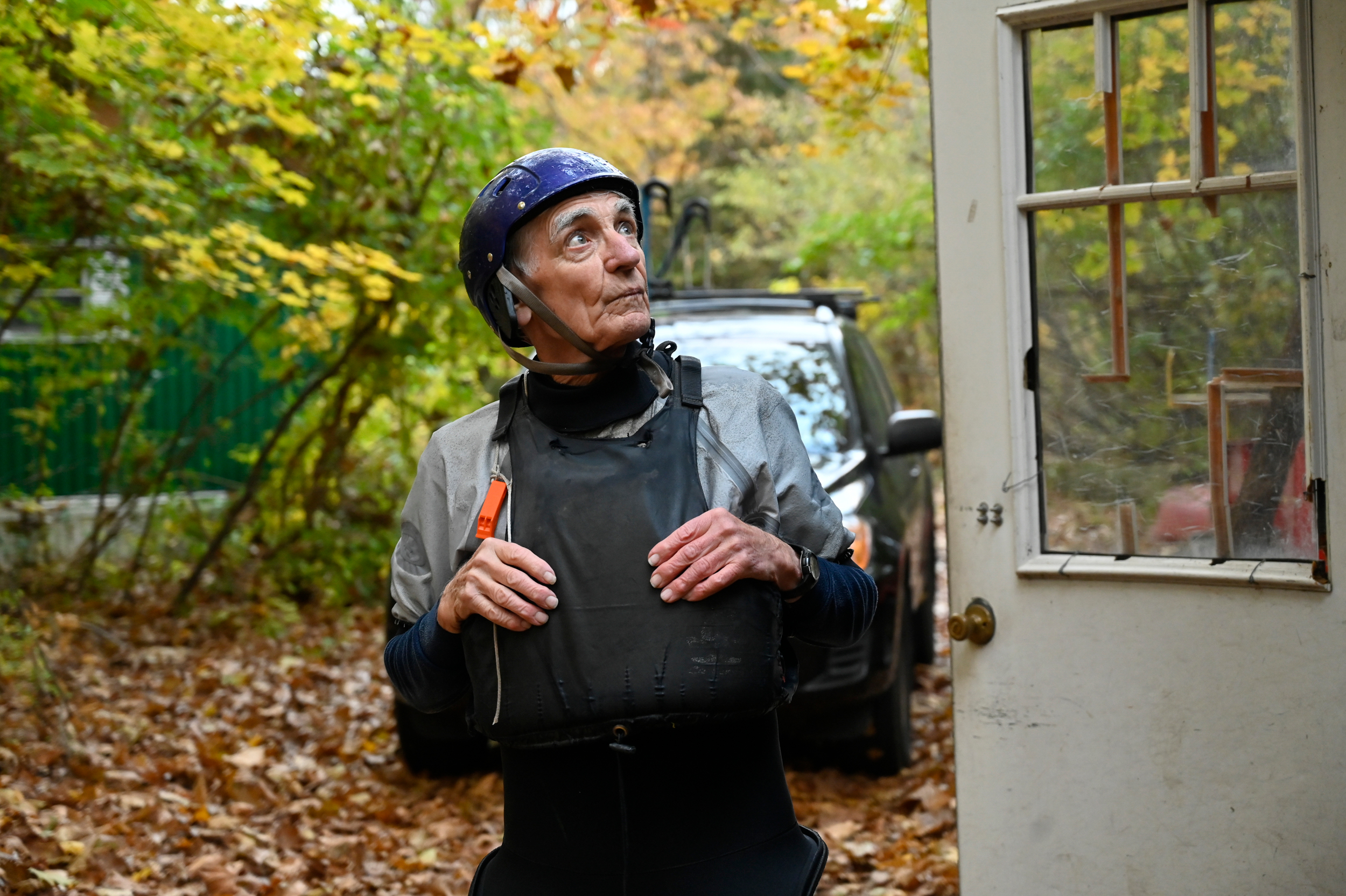
Standing across the road from Spring Creek, David Kurtz looks over the kayak and canoe shed outside of the Mach One team headquarters. ~ photo by Luke Vargas
Bart Beck, one of the owners of Tussey Mountain Outfitters — a paddle shop neighboring Spring Creek – said while Kurtz’s name isn’t one that everyone knows even in Centre County, where Bellefonte is the county seat, his prolific career as a paddler and a coach has created a unique network across the industry.
Rioux, who’s lived in State College for 15 years, said he’s spoken to people who’ve lived in Centre County for twice as long and have never heard the name David Kurtz or Sunnyside Paddle Park.
“He is a local legend that sort of goes under the radar,” Rioux said, “but there is definitely a network or group of people who have heard of Dave and know about this guy with just so much enthusiasm and commitment to the sport.”
At the moment, Kurtz is in the process of building a paddling museum in Talleyrand Park in Bellefonte. The town’s historical society gave Kurtz the building, a small, red structure sitting between a playground and an old train station, for the project.
One day last fall, he stood in the middle of a dark room in the building. Soft sunlight filtered through the dusty space. Kurtz was surrounded by dozens of old kayaks and canoes, some he owns and others that were given to him, to tell the story of kayaking and canoeing in Centre County.
Kurtz can recount the history of almost every boat and every paddle strewn about the unfinished space. Many of the boats’ owners are no longer living but many hold feats of exploration and Olympic competition that rival the legend of their new caretaker.
Kurtz remembers long and nuanced tales for each one, but acknowledged that he has trouble remembering all of them these days. His own story may be among those that matters least to him.
“Do I worry about being forgotten? Well, I don’t know, sure,” Kurtz said. “You have a certain amount of stuff that you’re concerned about, but I’m not worried about being forgotten.”
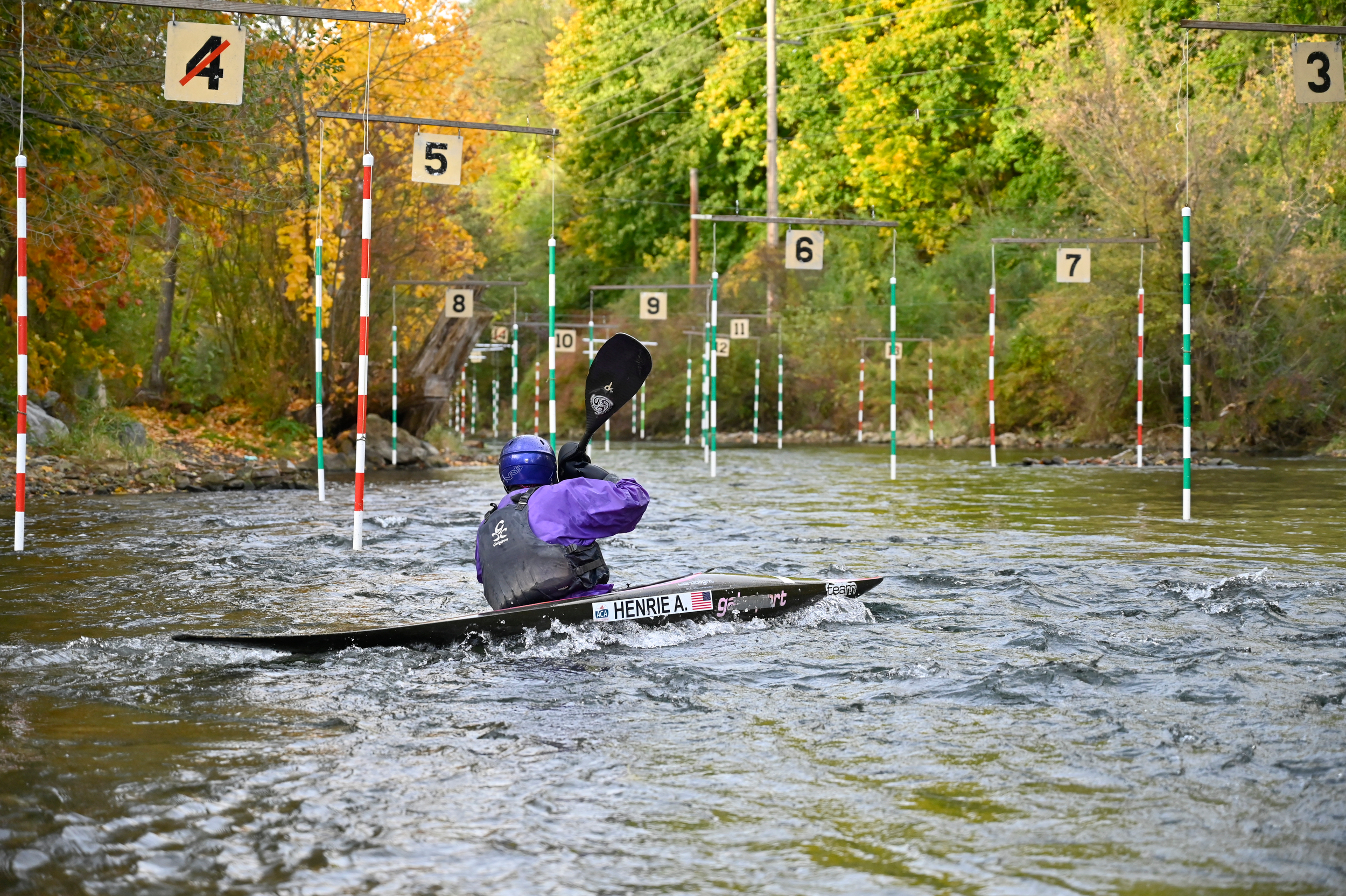
David Kurtz leans downstream to line up with the fifth gate of Sunnyside Paddle Park on Monday, Oct. 17, 2022, in Bellefonte, Pa. There are up to 30 gates set up at the paddle park, and they are open to use throughout the year. ~ photo by Luke Vargas
~ 02.20.2023